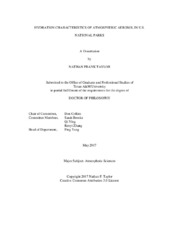| dc.description.abstract | Interactions with atmospheric water are central to aerosol impacts on health, climate, and visibility. Many atmospheric aerosol constituents take up water in sub-saturated conditions, enhancing their impact on climate and visibility by modifying the efficiency with which they scatter and absorb radiation. Particulate water also affects the evolution and fate of atmospheric aerosol, typically increasing the uptake of reactive and soluble trace gases, enhancing aerosol growth in both sub-saturated conditions and through cloud processing.
This dissertation explores the hydration characteristics of two major fractions of atmospheric aerosol: sulfates and water soluble organic carbon (WSOC). A series of four month-long measurement campaigns were conducted in three U.S. National Parks evaluating their role in visibility impairment and the validity of two assumptions in regulatory programs addressing visibility. First, while it is well known that under some atmospheric conditions sulfate aerosols exhibit two alternative hydration states—one aqueous, one crystalline—current regulatory programs assume that all atmospheric sulfate is aqueous and few measurements have tested this assumption. These campaigns included such measurements. During all studies, at least some aerosols with two possible hydration states under ambient conditions were detected (ranging from 4% at Acadia NP to 53% at Great Smoky Mountains NP in winter). Only during the winter at Great Smoky Mountains were aerosol found in both hydration states: 65 % of in the more hydrated state, 35 % in the less hydrated state. Otherwise, only the more hydrated alternative was occupied. We explore how these findings are related to composition, ambient RH, and other atmospheric conditions.
Next, we consider the uptake of water by WSOC in aerosol, which current U.S. regulations treat as negligible. During the four national park studies, and a fifth in remote northern Colorado, WSOC was captured on filters and isolated using selectively adsorptive resins. The ability of this WSOC to take up water or serve as a cloud condensation nuclei was measured. Across all sampling locations and seasons, the hygroscopic growth of WSOC samples at 90% RH, expressed in terms of the hygroscopicity parameter, κ, ranged from 0.05 – 0.15. | en |


